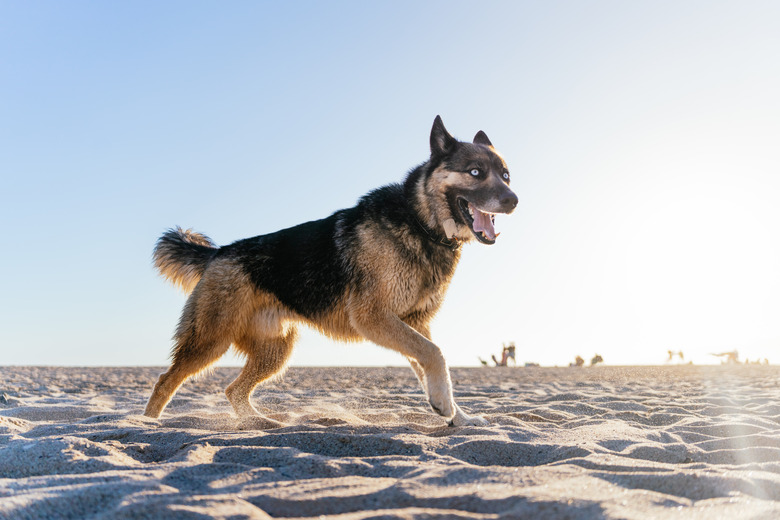Canine Rectal Bleeding: Causes, Symptoms & Treatments
A dog's stool or anal area may be bloody for many reasons, from constipation or rectal fistulas to intestinal inflammation or tumors. We spoke with Dr. Jordan Kautz, a veterinarian at Crestview Veterinary Clinic in Austin, Texas, to find out more. He says that a visit to your veterinarian is necessary to diagnose your pet and implement treatment.
Does my dog have impacted anal glands?
Does my dog have impacted anal glands?
Dogs have two anal glands, or anal sacs, just inside the anus on each side of it. Secretions in the glands are thick and oily and smell fishy. Many dogs can empty the anal glands just by walking around and through normal defecation, though some are unable to express the liquid themselves.
Canine anal glands can become impacted. "Your dog will scoot their rear end on the ground or lick the anus area to try to empty the glands," explains Dr. Kautz. If an anal sac is impacted, it can form an abscess that breaks through the skin and bleeds. "Your dog will need veterinary attention for treatment with antibiotics and anti-inflammatory drugs," noted Dr. Kautz.
Intestinal tumors in dogs
Intestinal tumors in dogs
Two of the most common areas for malignant intestinal tumors in canines are the colon and the rectum. A benign form is polyps in the rectum as an abnormal growth of tissue. Older collies and German shepherds between 6 and 9 years of age are predisposed to these conditions.
Symptoms of intestinal tumors include weight loss, diarrhea, anorexia, vomiting, and a bloody stool. Diagnostic testing may include a complete blood count, physical examination, chemistry profile, ultrasound, endoscopy, and laparoscopy. In most cases, veterinarians surgically remove the tumors. A veterinarian may remove a benign rectal tumor through transrectal endoscopy.
Canine rectal fistulas
Canine rectal fistulas
Rectal fistulas and perianal fistulas are abnormal tunnel-like tracts that form in the tissues surrounding a dog's anal area, usually in the skin but sometimes in the deeper tissues. They vary in severity but initially appear as small, oozing fissures around the anal area that widen and deepen with time.
Infected or obstructed anal glands can cause rectal fistulas, though most cases are thought to be a result of an autoimmune disease, such as inflammatory colitis or inflammatory bowel disease. Male German shepherds are most susceptible, but females and other breeds, including Irish setters and Labrador retrievers, can develop the condition. "Auto-immune disease causing rectal fistulas is more common in German shepherds, but true rectal trauma from swallowing sharp objects is rare," says Dr. Kautz. "Usually, sharp objects would cause issues with the stomach and upper gastrointestinal tract before it gets to the colon."
Signs of rectal or perianal fistulas include redness, inflammation and discharge around the anal area, constipation, reluctance to defecate, and reluctance to eat. Diagnostic testing may include a physical exam, biopsy, blood tests, and ultrasound. Dr. Kautz says ultrasound is more commonly used than an X-ray in cases like these.
If a veterinarian suspects your pet has colitis or another autoimmune disorder, they may prescribe immune-modulating medications. They may also prescribe steroids, pain medication, and stool softeners to reduce inflammation and discomfort and restore appetite. Because disorders affecting the gastrointestinal tract are often caused by food sensitivities or allergies, your veterinarian may recommend dietary changes.
Colitis and proctitis in dogs
Colitis and proctitis in dogs
Canine ulcerative colitis is a bowel disease that causes thickening of the colon and ulcers to appear in the lining. An inflamed colon leads to a reduction in water absorption needed to store feces and leads to frequent, bloody diarrhea. A dog's stool may also contain mucus. Proctitis is the inflammation of a dog's anal area and the rectal lining. Each time a dog poops, it can irritate the inflamed colon and rectum tissue and cause it to tear. The irritation can lead to vomiting and weight loss from lack of appetite.
Both colitis and proctitis can be caused from parasites in the rectum or intestines; a bacterial, fungal, or algae infection; or from eating an abrasive foreign body that causes intestinal trauma. Treatment may include hospitalization of your pet to rehydrate them if they are dehydrated from excessive diarrhea. If the inflammation is sudden and significant, food may be withheld for 24 to 48 hours so the colon can relax.
"In severe cases, an ultrasound or surgical exploration may reveal a bowel wall that is damaged beyond repair and needs surgical resection," explains Dr. Kautz. An X-ray can also indicate thick scarring on the colon. In this instance, a veterinarian may need to surgically remove heavily scarred tissue.
Why is my dog constipated?
Why is my dog constipated?
Dogs with constipation may whimper or cry during defecation and strain to defecate with either a hard or bloody stool, including mucous. You need to take your pet to the veterinarian for a diagnosis and treatment program.
The veterinarian will likely do a physical exam, a complete blood count, an electrolyte panel, a urinalysis, and a blood chemical profile. Your veterinarian may also do an ultrasound or use X-rays to see inside the digestive tract. They may prescribe antibiotics, anti-inflammatory medications, and laxatives depending on the cause of the constipation.
The bottom line
The bottom line
Occasional constipation doesn't necessarily signal a serious pet health issue, but if you see your dog bleeding from the anal are if your dog's stool is bloody, if constipation lasts more than a day or two, or if defecation appears painful, talk to your veterinarian. Likewise, if your dog is vomiting; scooting; reluctant to eat; or has rectal bleeding or a red or inflamed rectal area, seek care from your DVM. If you suspect a bowel obstruction, find an emergency vet. Chronic constipation and other digestive tract issues can diminish your dog's quality of life, but most conditions, from impacted anal glands to intestinal tract inflammation, are treatable with proper care.


